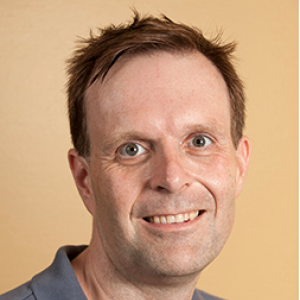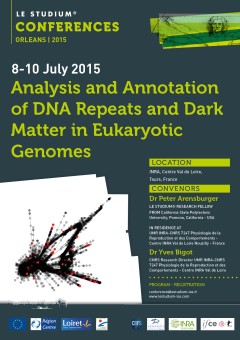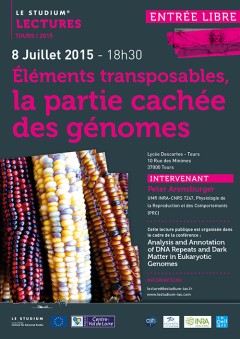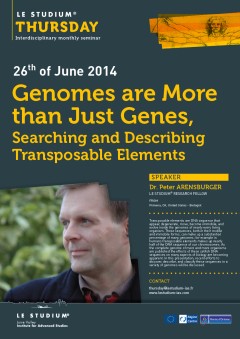Dr Peter Arensburger

From
California State Polytechnic University - USA
In residence at
Host scientist
Dr. Yves Bigot
PROJET
Impact of space segregation between micro and macrochromosomes on distributions of both kinds of transposable elements in avian genomes
This project is primarily concerned with studying the dynamics and distribution of transposable elements (TEs) in avian genomes. A secondary objective is to determine whether the organization of avian genomes into macro-and micro-chromosomes, a feature that is absent in other animal taxa, interferes with the ability of TEs to transpose and to recombine within chromosomes. This information is of crucial importance for the improvement of races because TEs are known to be an important source of genetic variability among eukaryotic species and are involved in certain differentiation processes during development and tissue differentiation.
The structuring objective of this project is to improve bioinformatic analysis tools for use with important farm animal genomes by supporting the creation of a new genomics research team within the Centre INRAE Val de Loire, PRC research unit.
Publications
Efforts to elucidate the causes of biological differences between wild fowls and their domesticated relatives, the chicken, have to date mainly focused on the identification of single nucleotide mutations. Other types of genomic variations have however been demonstrated to be important in avian evolution and associated to variations in phenotype. They include several types of sequences duplicated in tandem that can vary in their repetition number. Here we report on genome size differences between the red jungle fowl and several domestic chicken breeds and selected lines. Sequences duplicated in tandem such as rDNA, telomere repeats, satellite DNA and segmental duplications were found to have been significantly re-shaped during domestication and subsequently by human-mediated selection. We discuss the extent to which changes in genome organization that occurred during domestication agree with the hypothesis that domesticated animal genomes have been shaped by evolutionary forces aiming to adapt them to anthropized environments.
Transposable element (TE) science has been significantly influenced by the pioneering ideas of David Finnegan near the end of the last century, as well as by the classification systems that were subsequently developed. Today, whole genome TE annotation is mostly done using tools that were developed to aid gene annotation rather than to specifically study TEs. We argue that further progress in the TE field is impeded both by current TE classification schemes and by a failure to recognize that TE biology is fundamentally different from that of multicellular organisms. Novel genome wide TE annotation methods are helping to redefine our understanding of TE sequence origins and evolution. We briefly discuss some of these new methods as well as ideas for possible alternative classification schemes. Our hope is to encourage the formation of a society to organize a larger debate on these questions and to promote the adoption of standards for annotation and an improved TE classification.
Transposable elements are driving forces for establishing genetic innovations such as transcriptional regulatory networks in eukaryotic genomes. Here, we describe a silencer situated in the last 300 bp of the Mos1 transposase open reading frame (ORF) which functions in vertebrate and arthropod cells. Functional silencers are also found at similar locations within three other animal mariner elements, i.e. IS630-Tc1-mariner (ITm) DD34D elements, Himar1, Hsmar1 and Mcmar1. These silencers are able to impact eukaryotic promoters monitoring strong, moderate or low expression as well as those of mariner elements located upstream of the transposase ORF. We report that the silencing involves at least two transcription factors (TFs) that are conserved within animal species, NFAT-5 and Alx1. These cooperatively act with YY1 to trigger the silencing activity. Four other housekeeping transcription factors (TFs), neuron restrictive silencer factor (NRSF), GAGA factor (GAF) and GTGT factor (GTF), were also found to have binding sites within mariner silencers but their impact in modulating the silencer activity remains to be further specified. Interestingly, an NRSF binding site was found to overlap a 30 bp motif coding a highly conserved PHxxYSPDLAPxD peptide in mariner transposases. We also present experimental evidence that silencing is mainly achieved by co-opting the host Polycomb Repressive Complex 2 pathway. However, we observe that when PRC2 is impaired another host silencing pathway potentially takes over to maintain weak silencer activity. Mariner silencers harbour features of Polycomb Response Elements, which are probably a way for mariner elements to self-repress their transcription and mobility in somatic and germinal cells when the required TFs are expressed. At the evolutionary scale, mariner elements, through their exaptation, might have been a source of silencers playing a role in the chromatin configuration in eukaryotic genomes.



